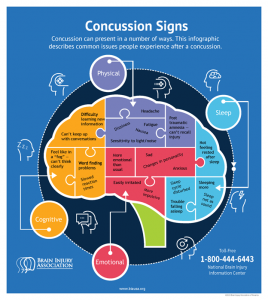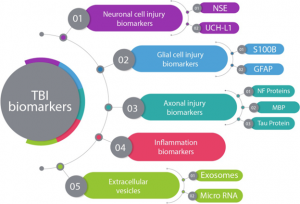Imagine an athlete taking a hard hit during a game. They seem fine—no visible injury on a brain scan—but beneath the surface, a silent storm is unfolding. The impact triggers a neurometabolic cascade, a chain reaction that disrupts the brain’s delicate balance. Ions flood in and out of neurons, and a surge of glutamate—a key neurotransmitter—fires indiscriminately, setting off a wave of cellular chaos. To restore order, the brain scrambles to pump ions back into place, demanding enormous amounts of energy. But here’s the problem: blood flow remains restricted, creating a metabolic crisis where the brain is starving for fuel just when it needs it most.
In the following hours and days, this energy imbalance lingers, leaving the brain in a fragile state. The axons—the brain’s communication highways—are stretched and damaged, slowing down thought and reaction time. Neurotransmitters misfire, affecting mood, memory, and cognitive function. Meanwhile, inflammation and oxidative stress take their toll, making the brain more vulnerable to further injury. If a second concussion happens before the brain fully recovers, the damage can be exponentially worse, with a higher risk of long-term impairment. [1]
The Role of Age in Concussion Recovery
Recovery from a concussion isn’t the same for everyone. Age plays a significant role in how the brain responds to injury. There’s ongoing debate about whether younger or older individuals are more vulnerable. Children’s brains are still developing, which may make them more susceptible to injury—but also more resilient in terms of recovery. Some studies suggest that children aged 10-14 have the highest rates of emergency visits for sports-related concussions (SRCs), yet their long-term outcomes may not necessarily be worse than adults. However, repeated concussions during this critical developmental stage can lead to longer recovery times and exacerbate symptoms. [2]
On the other hand, older adults face unique challenges in concussion recovery. Research suggests that multiple concussions can accelerate cognitive decline and increase the risk of mild cognitive impairment (MCI) and Alzheimer’s disease. Former athletes who have suffered repeated concussions often show subtle deficits in attention and motor control—effects that may not be immediately noticeable but can surface later in life. A study comparing high school and college athletes found no major difference in concussion severity, although younger athletes took slightly longer to return to baseline. [2]
 [3]
[3]
The Search for Biomarkers
With concussions being difficult to diagnose through traditional imaging, researchers are turning to biomarkers—biological indicators that can help detect and track brain injury. Several key biomarkers have been identified:
Astroglial Injury: Elevated levels of S100β and glial fibrillary acidic protein (GFAP) indicate astrocyte activation due to brain trauma. [4]
Neuronal Injury: Neuron-specific enolase (NSE) and ubiquitin carboxyl-terminal hydrolase L1 (UCH-L1) are released when neurons are damaged, with UCH-L1 levels being linked to intracranial lesions seen on CT scans.
Axonal Injury: Structural proteins like Alpha-II-spectrin, tau, and neurofilament light protein (NFL) provide insight into axonal damage, with tau deposits being particularly concerning due to their association with Alzheimer’s disease. [4]
 [5]
[5]
The Long-Term Impact
For many, the symptoms of concussion—headaches, dizziness, and light sensitivity—feel eerily similar to migraines. This overlap isn’t a coincidence; research suggests that the same metabolic dysfunction seen in concussion may also underlie migraines. [6] More concerning is the potential for repeated concussions to contribute to chronic neurodegeneration, with evidence linking multiple head injuries to conditions like chronic traumatic encephalopathy (CTE).
Scientists are now using advanced imaging and biomarkers to track these changes in real-time, searching for ways to better diagnose, treat, and prevent long-term damage. As we learn more, one thing is clear: the effects of a concussion don’t end when the symptoms fade—what happens in those critical early days may set the stage for brain health years down the line.
Learn more about the science behind concussions at The New Neurometabolic Cascade of Concussion
[1]
C. Giza and D. A. Hovda, “The New Neurometabolic Cascade of Concussion,” Neurosurgery, vol. 75, no. Supplement 4, pp. S24–S33, Oct. 2014, doi: 10.1227/NEU.0000000000000505.
[2]
A. Hoge, J. Vanderploeg, M. Paris, J. M. Lang, and C. Olezeski, “Emergency Department Use by Children and Youth with Mental Health Conditions: A Health Equity Agenda,” Community Ment Health J, vol. 58, no. 7, pp. 1225–1239, Oct. 2022, doi: 10.1007/s10597-022-00937-7.
[3]
Concussion Infographics & Fact Sheets. [Online]. Available: https://biausa.org/public-affairs/media/concussion-awareness-infographics
[4]
Papa, “Potential Blood-based Biomarkers for Concussion,” Sports Medicine and Arthroscopy Review, vol. 24, no. 3, pp. 108–115, Sep. 2016, doi: 10.1097/JSA.0000000000000117.
[5]
S. Ghaith et al., “A Literature Review of Traumatic Brain Injury Biomarkers,” Mol Neurobiol, vol. 59, no. 7, pp. 4141–4158, Jul. 2022, doi: 10.1007/s12035-022-02822-6.
[6]
Sachdev and M. J. Marmura, “Metabolic Syndrome and Migraine,” Front. Neur., vol. 3, 2012, doi: 10.3389/fneur.2012.00161.